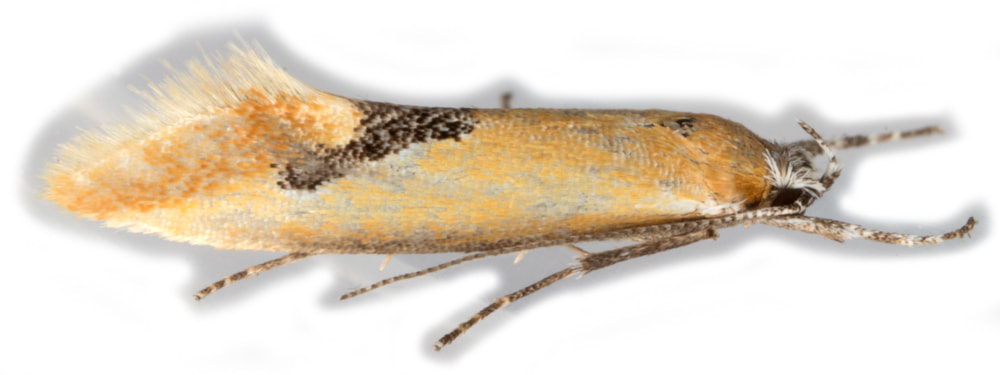Batia
Generic features: Head tufted at sides and posteriorly; Antenna 3/4 fw length; ciliate in male; scape with pecten; Labial palps long, slender; S2>S3 in other species
Fw V8&7 stalked, V2 arising from 4/5 length of cell; Hw V4&3 connate
Male genitalia: vinculum >1/2 length of valva; pointed process at end of sacculus
Fw V8&7 stalked, V2 arising from 4/5 length of cell; Hw V4&3 connate
Male genitalia: vinculum >1/2 length of valva; pointed process at end of sacculus
The 3 species have similar forewing markings but distinguishing them can usually be done on the basis that -
B.internella is rare and confined to pine and larch woodland in Herefordshire, Wiltshire and Hertfordshire and the remaining 2 species do not overlap in size - B.lunaris ws9-11mm, B.lambdella ws 13-18mm.
Perhaps the best fw mark is the pre-tornal black lambda: in B.lunaris it has a narrow base and tapers abruptly to a linear process; in B.internella it has a broader base and tapers gradually to a pointed process; in B.lambella it also has a broader base and tapers gradually but to a rounded end.
Minor genital differences will confirm ID.
B.internella is rare and confined to pine and larch woodland in Herefordshire, Wiltshire and Hertfordshire and the remaining 2 species do not overlap in size - B.lunaris ws9-11mm, B.lambdella ws 13-18mm.
Perhaps the best fw mark is the pre-tornal black lambda: in B.lunaris it has a narrow base and tapers abruptly to a linear process; in B.internella it has a broader base and tapers gradually to a pointed process; in B.lambella it also has a broader base and tapers gradually but to a rounded end.
Minor genital differences will confirm ID.
B.lunaris |
B.internella |
B.lambdella |
|
wingspan |
9-11mm |
9-13mm |
13-18mm |
forewing length |
|||
costal half of lambda mark |
reduced to a line |
tapers to a pointed end |
tapers to a rounded |
male genitalia: sacculus |
basal half of even width, then tapers to a point that reaches end of valva* |
basal half of even width, then tapers to a point that reaches end of valva* |
tapers from base to 2/3, narrow in apical 1/3, point does not reach apex of valva |
male genitalia: cornutus |
large - occupies >1/2 length of aedeagus and nearly all its width, tapers from base |
? as B.lunaris but slightly shorter |
smaller - occupies ~1/3 length of aedeagus, abruptly narrows from base |
Female genitalia: posterior and anterior margins of S8 plate and see below |
emarginate ~straight |
shallowly emarginate ~straight |
~straight emarginate |
Distribution |
common in England & Wales |
rare in pine and larch woodland in Herefordshire, Wiltshire and Hertfordshire |
common in England & Wales |
* The drawings in MBGBI4.1 show the sacculus of B.lunaris tapering more abruptly than that of B.internella, but the images of B.lunaris at Moth Dissection and from my specimens of B.lunaris show a sacculus looking more like the MBGBI drawing of B.internella than that of B.lunaris.
Female genitalia: (based on the drawings in MBGBI4.1 p57) - All three species have a rounded, somewhat spiculate, signum in the bursa copulatrix (BC) and a series of small spicules at the posterior end of the ductus bursae (DB). Differences occur in the shape of the periosteal plate (S8 ventral plate) and in the DB-BC junction. In B.lambdella the posterior margin of the ventral S8 plate is fairly straight, the anterior margin has rounded projection on each side of a medial emargination and the ostium is in the posterior half of the plate; in B.lunaris the posterior margin is deeply emarginate, the anterior margin has small projections on each end of a fairly straight edge and the ostium opens in the anterior half of the plate; in B.internella the posterior margin is shallowly emarginate, the anterior margin is straight and the ostium opens more or less in the centre of the plate. In B.lunaris the DB is just under half the diameter of the CB; in both B.lambdella and B.internella the DB is much narrower than the CB (~1/5); in both B.lunaris and B.internella the DB joins the CB at its posterior pole but in B.lambdella the junction is near the anterior end of the CB so that the CB is somewhat recurved on the DB.
Page published 16/09/2018









